
WooCommerce Market Share – A Comparative Statistical Evaluation
WooCommerce Market Share
We measure a company’s total market share by measuring its sales as the industry’s total revenue percentage. To measure a company’s market share, we need to divide its total sale or revenue by the industry’s total revenue over the year. The reason we measure a company’s market share is to get an overall idea of the size of the company compared to the entire industry.
In this blog, we will be talking about WooCommerce Market Share, Its Impact on the World’s Market Share in the E-commerce business, and how it stands up compared to its competitors. We will also be analyzing lots of statistics and infographics to give you a clear view of the context of today’s topic. So without further ado, let’s get started.
Some Amazing Stats On WooCommerce
Let’s get to know about some of the fantastic stats on WooCommerce and have some idea about what this company has done over the years.
- The total number of downloads of the Official WooCommerce plugin is 155,691,987 times from WordPress.org and counting. (29th September 2021)
- The total number of live websites using WooCommerce is 3,876,748; 8.5% of all websites and 15% among all the eCommerce websites. (January 2021)
- People are downloading WooCommerce at least 30,000+ times every day.
- It’s leading the eCommerce platform with well over 23% of the total market share.
- The WooCommerce plugin available on WordPress supports 66 different languages.
- According to the stats of 2019, The GMV- Gross Merchandise Volume of WooCommerce stores had estimated an enormous $11.8B.
Infographics
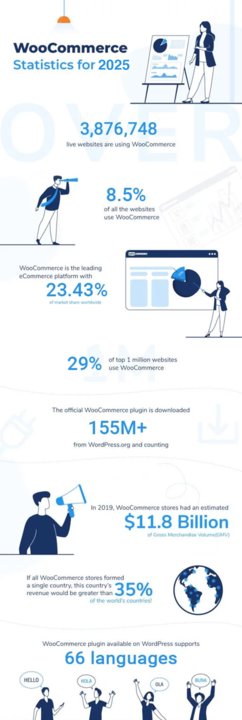

WooCommerce Market Share and Usage Stats
At this point, we all know WooCommerce has the largest market share among its competitors in the eCommerce industry. Let’s have a look at some of the impressive usage statistics of WooCommerce.
- WooCommerce has the largest market share of a whopping 23.43% among the entire eCommerce industry.
According to the latest report of Statista (April 2021), WooCommerce is one of the leading eCommerce platforms with an enormous 23.43% market share worldwide. And two of its closest competitors of WooCommerce are Shopify and Magento, which have a market share of 3.69% and 2.32%, respectively. And you can see the difference between WooCommerce with its closest competitors is pretty much enormous. It shows how ahead WooCommerce is of the competition.
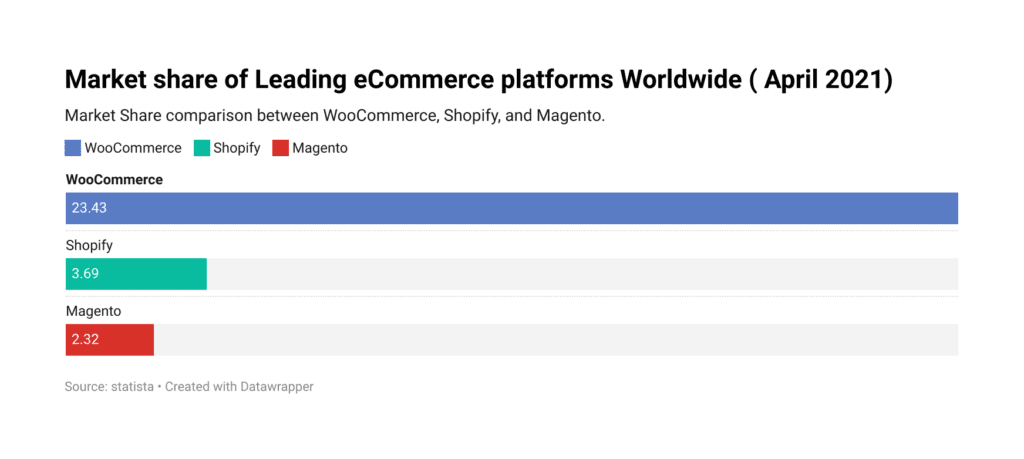
- WooCommerce is used by 20% of All WordPress Websites.
According to the latest usage statistics of W3 Techs (28th September 2021), 42.6% of the websites on the entire internet are powered by WordPress. And among that 46.6% of those WordPress websites, a total of 20% uses WooCommerce, which is 8.5% of all the websites on the internet.
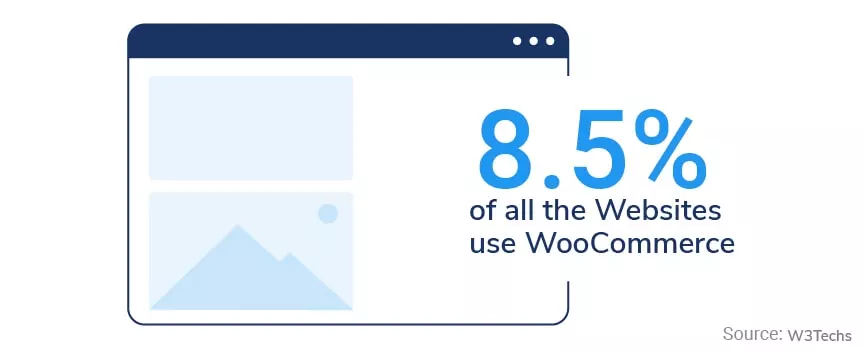

And in another part of their stats, they showed a diagram where they have listed the most used WordPress plugins based on the user statistics.
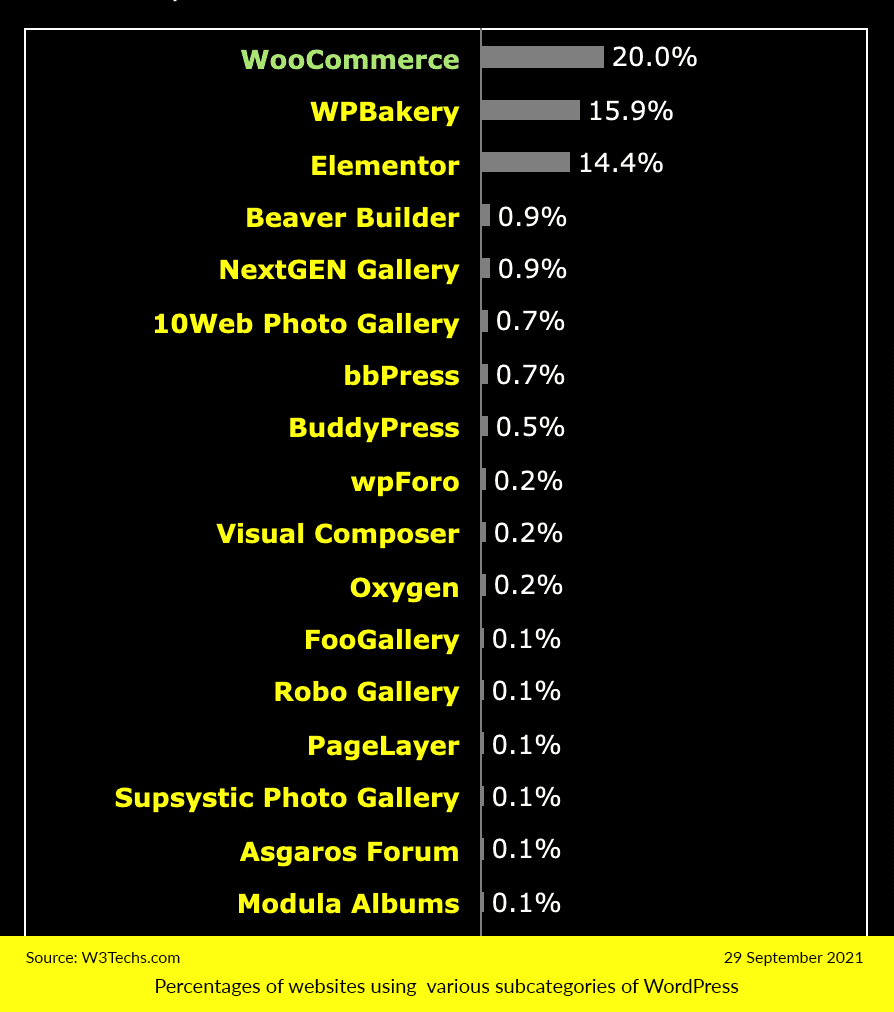
In the list, WooCommerce is at the top with 20% usage. After WooCommerce, there’s WPBakery with 15.9% of total users and Elementor with 14.4%, respectively. And the rest of the competitors are below 1%. So it’s evident that the usage percentage of the WooCommerce plugin is way higher than its competitors.
Some More Incredible Stats on WooCommerce
- According to Wikipedia, The current market share (2021) of WooCommerce is an impressive indication, making it 29% of the top 1 Million eCommerce sites.
- At least 3.8M+ live sites are using WooCommerce.
BuiltWith report states that in January 2021, a total number of 3,876,748 live websites use WooCommerce.

Stats on WooCommerce Plugins
- There are over 1000+ WooCommerce plugins available on WordPress.org and counting.
- Another popular marketplace CodeCanyon has a total number of 1221 WooCommerce Plugins.
- According to the data of the Official WooCommerce Store, WooCommerce.com currently has more than 730 official plugin extensions and themes.
- WooCommerce Plugin from WordPress.org supports a total of 66 languages.

Stats on WooComerce Themes
- WooComerce has over 1312 themes on ThemeForest.
- The theme directory of WordPress.org has 1224 WooCommerce compatible themes.
- The most popular WordPress WooCommerce theme, Astra, has over 1 Million active installations.
Some Influential WooCommerce Stats
- Total lifetime downloads of the Official WooCommerce Plugin from WordPress.org is 155M+ and counting.
- In the year 2020, WooCommerce facilitated over $20 Billion worth of sales.


- In the open-source category, WooCommerce is the second most popular platform on the internet, right after WordPress.
- One in every four eCommerce stores is powered by WooCommerce, including some of the top-rated websites like Chaka Khan, AeroPress, and New Zealand All Blacks Official Store, etc.
- In 2019, The GMV- Gross Merchandise Volume of all WooCommerce stores was estimated at $11.8 Billion.
- WooCommerce’s repository on GitHub has a total number of 1048 contributors and counting.
WooCommerce Vs. its Competitors eCommerce Platform Market Share [Worldwide]
It’s not an easy task to get accurate statistics of the market share of WooCommerce and its competitors, as the market share is not a static curve, and it fluctuates every now and then. The best we can do here is to find out the latest information on the eCommerce market share worldwide and share it with you all to get the idea of the WooCommerce market share and how they’re holding up compared to their competitors.
There’s no denying that the eCommerce platform is booming and getting famous every day. As time progresses, people are getting more and more dependent on the eCommerce platform and shifting towards it from the conventional marketplace.
For a start-up business in the eCommerce industry, it’s a must to get a proper overview of the top eCommerce platforms and their market share. It will surely help you choose the right platform for your eCommerce website according to the type of your business and market preferences.
Infographics
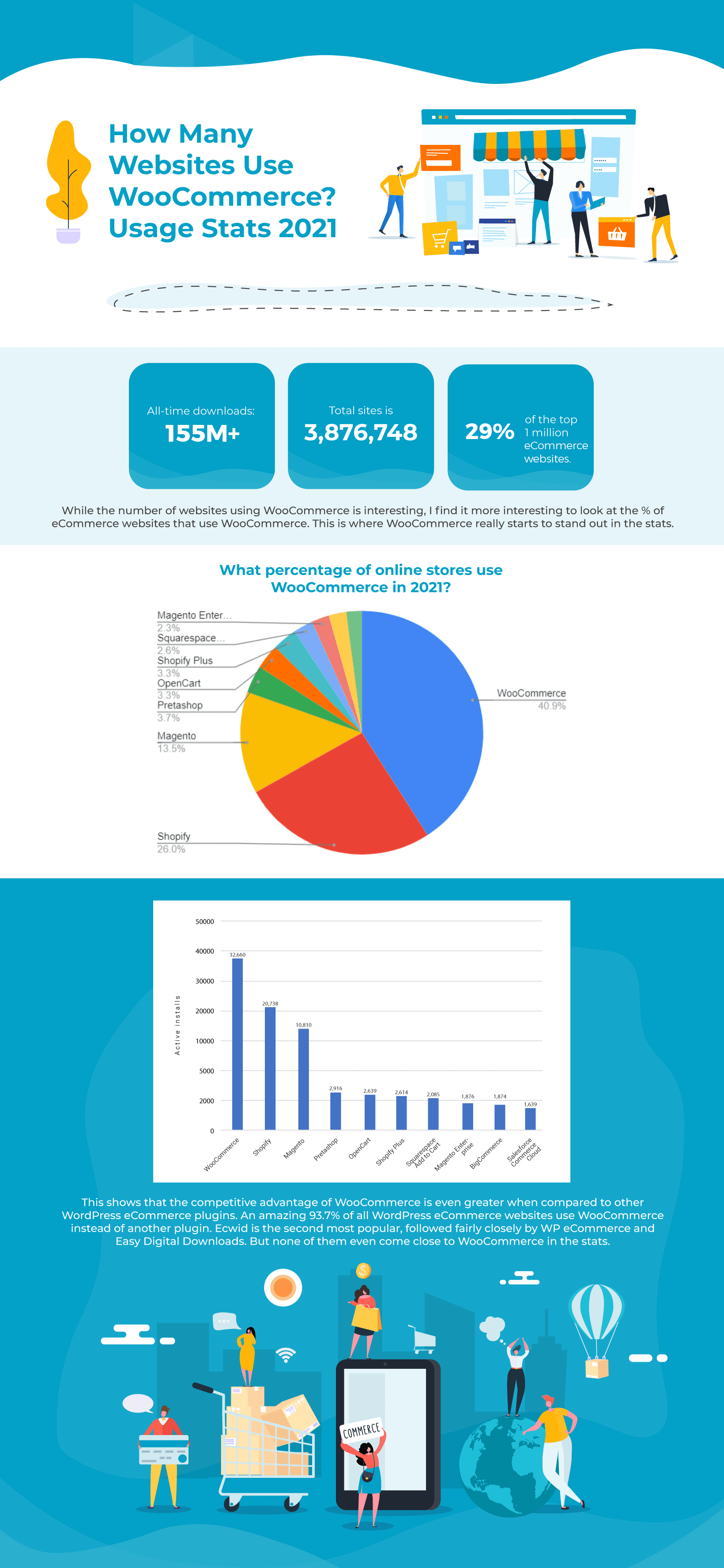
By looking at the pie chart of the infographics above, you will see that 40% of the online stores use WooCommerce. And two of its major competitors Shopify and Magento, are placed in the 2nd and 3rd position with 26% and 13.5% of total online stores, respectively.
So, of course, there is competition in the eCommerce market, especially between these three companies. But if you look at the numbers, it is also clear that WooCommerce is well ahead of its competitors.
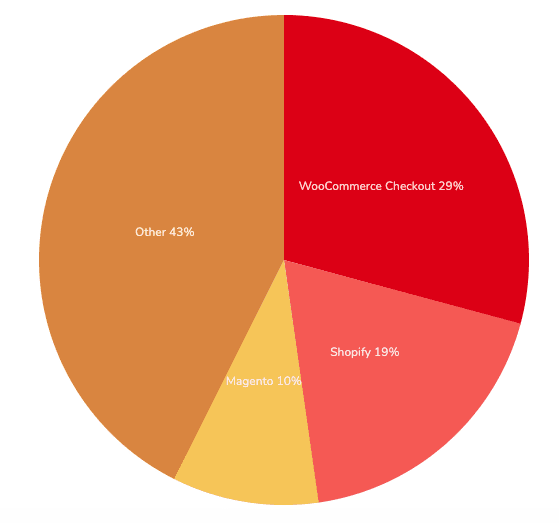
Pie Chart: Current BuiltWith data of the market share of the top 1 Million sites using eCommerce technology. (2021)
Here also, WooCommerce is leading the chart with a 29% market share of the top 1 Million eCommerce websites in 2021. But if you go back to 2020, the number for WooCommerce market share was 26%. That shows the market growth of WooCommerce is still rising.
Another fun fact is if you combine the market share of WooCommerce’s primary competitors Shopify and Magento [(19+10)% = 29%], the output that comes is precisely the same as the market share of WooCommerce Checkout, which is also 29%. It proves that WooCommerce’s market share is dominating the competition in the top 1 Million eCommerce websites.

WooCommerce Vs. Their Competitors eCommerce Platform Market Share [In the USA]
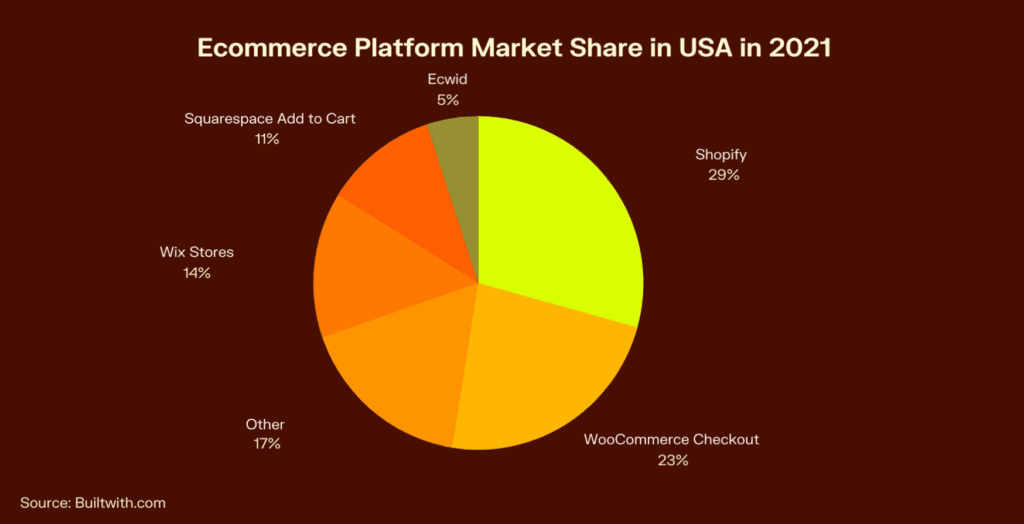
The USA has the second largest eCommerce market in the entire World with plenty of business opportunities. So if you want to launch an online store of your own and get into the eCommerce business, it’s essential to get an overall idea of the leading eCommerce platforms and their market share in the USA. Unlike other parts of the World, the USA’s eCommerce market share has a fairly different scenario.
According to the 2021 stats, Shopify is leading the market share with 29% of the eCommerce market share in the USA. However, WooCommerce Checkout doesn’t fall too much behind Shopify. It quickly took second place with 23% of the market share. And two of them combined to make it 52% of the eCommerce market share in the USA, which is more than half of the entire market.
The third and the fourth places are taken by Wix Stores and Squarespace with 14% and 11% of the market share respectively in the USA. Ecwid takes the fifth position in the total market share with a considerably smaller 5% of the market.
WooCommerce Vs. Shopify [In The USA]
- Total Number of Online Stores:
In the USA, WooCommerce is powering over 1.8 Million online stores against Shopify’s 2.3 Million stores. Hence, Shopify is slightly ahead of WooCommerce but definitely not by much, according to the USA’s stats of the eCommerce market share.
- Target Vendors:
Statistics show that sports, health, foodstuffs, and automotive-related online stores mostly choose WooCommerce to run their business. At the same time, stores are based on culinary, fitness, fashion, comics. etc., are maintained via Shopify. So, you see! WooCommerce and Shopify both have their own unique niche in terms of their target vendors.
- State-Based Statistics:
The majority of the eCommerce vendors in the USA are located in California, New York, and Florida. Around 59,000 online businesses use WooCommerce Checkout stores in California, whereas around 56,300 businesses use Shopify as their preferred eCommerce platform.
Apart from California, around 54,400 online stores in New York and 29,000 stores in Florida use WooCommerce checkout. And the numbers for Shopify are approximately 24,900 stores in New York and 20,800 stores in Shopify.

ShopRank Stats on WooCommerce
Now let’s look at some of the impressive statistics on WooCommerce market share, competitors, geographic usage, movements, and many more from the ShopRank website.
WooCommerce Details
Before getting into the deeper part, let’s look at some of the basic details of WooCommerce.
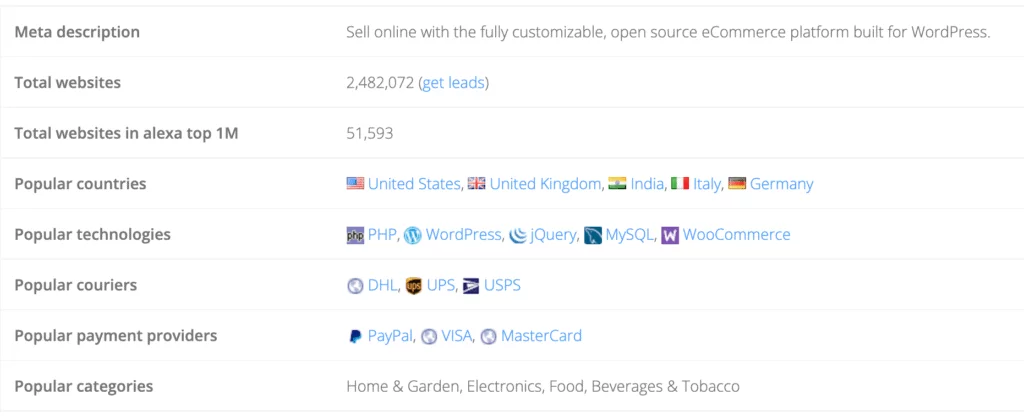
Here you can see some of the basic details of WooCommerce, including its entire websites, total websites in Alexa (top 1 Million), popular countries, technologies, couriers, payment gateway providers like Stripe, and categories.
Top retailers using WooCommerce (Ranked by Alexa)
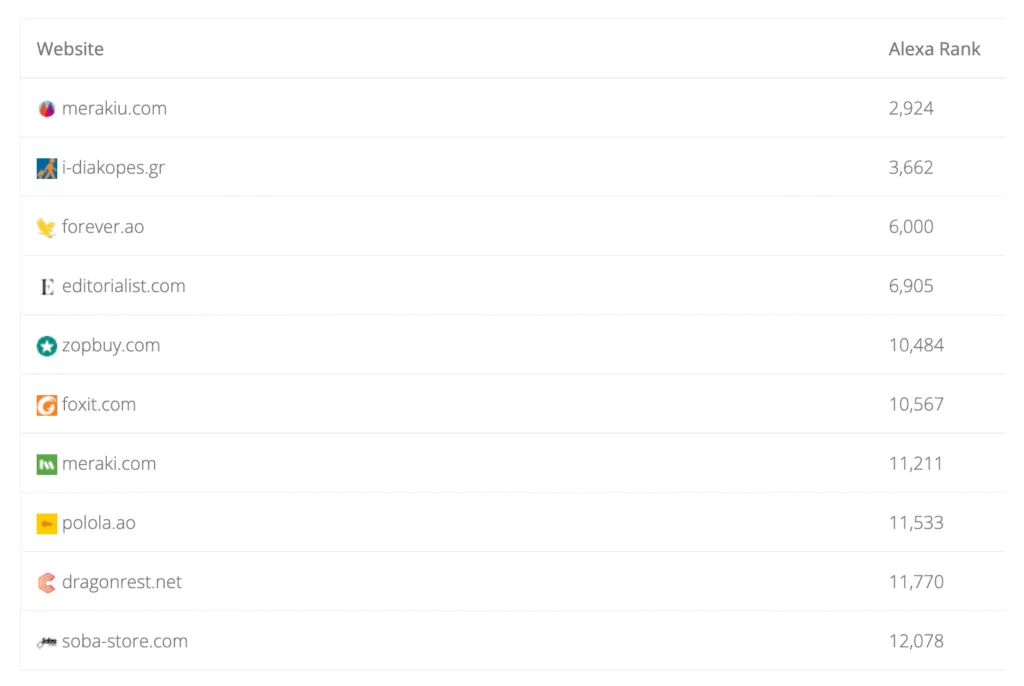
Here is the list of the top retailers of the World that are using WooCommerce ranked by Alexa. In the list, you can see some of the giant retailer companies like MERAKIU, i-diakopes, and Forever are running their websites using the WooCommerce platform.
Retailers Using WooCommerce (Ranked by Country)
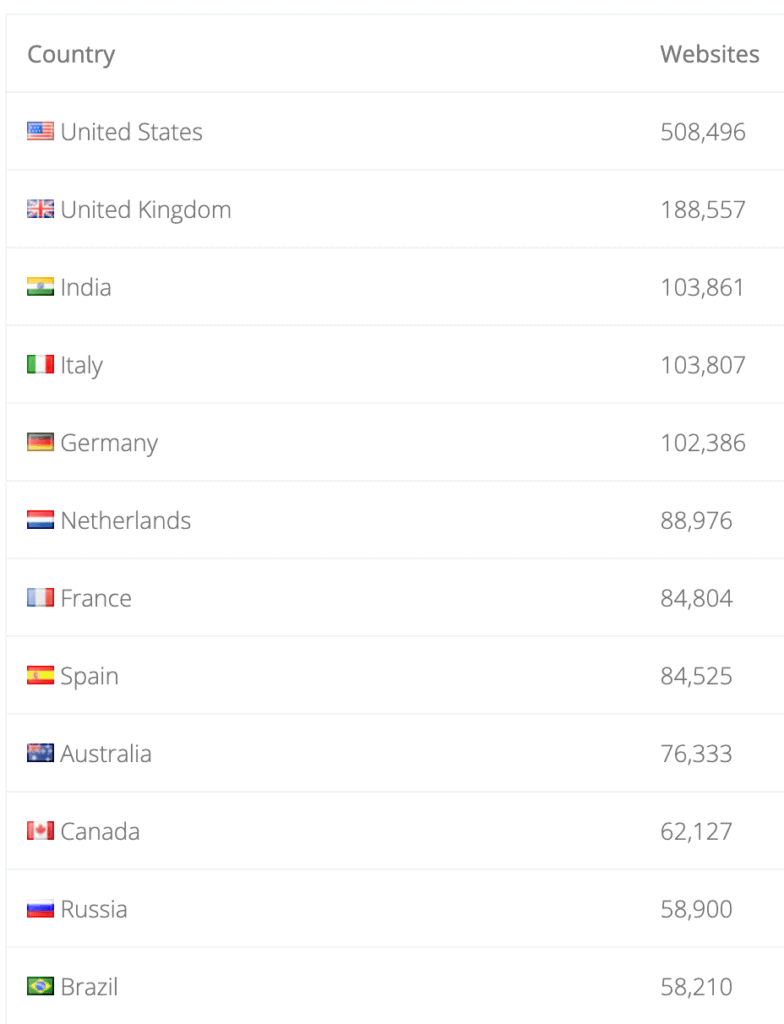
In the list above, you can see the top-ranked countries based on the highest number of websites using WooCommerce.
The list goes up to the top 12 countries. As you can see, the USA, UK, India, Italy, and Germany are the leading five countries based on the number of websites worldwide. The number of websites included in the list only covers retailers’ websites that use WooCommerce.
WooCommerce Traffic Growth 2020-21
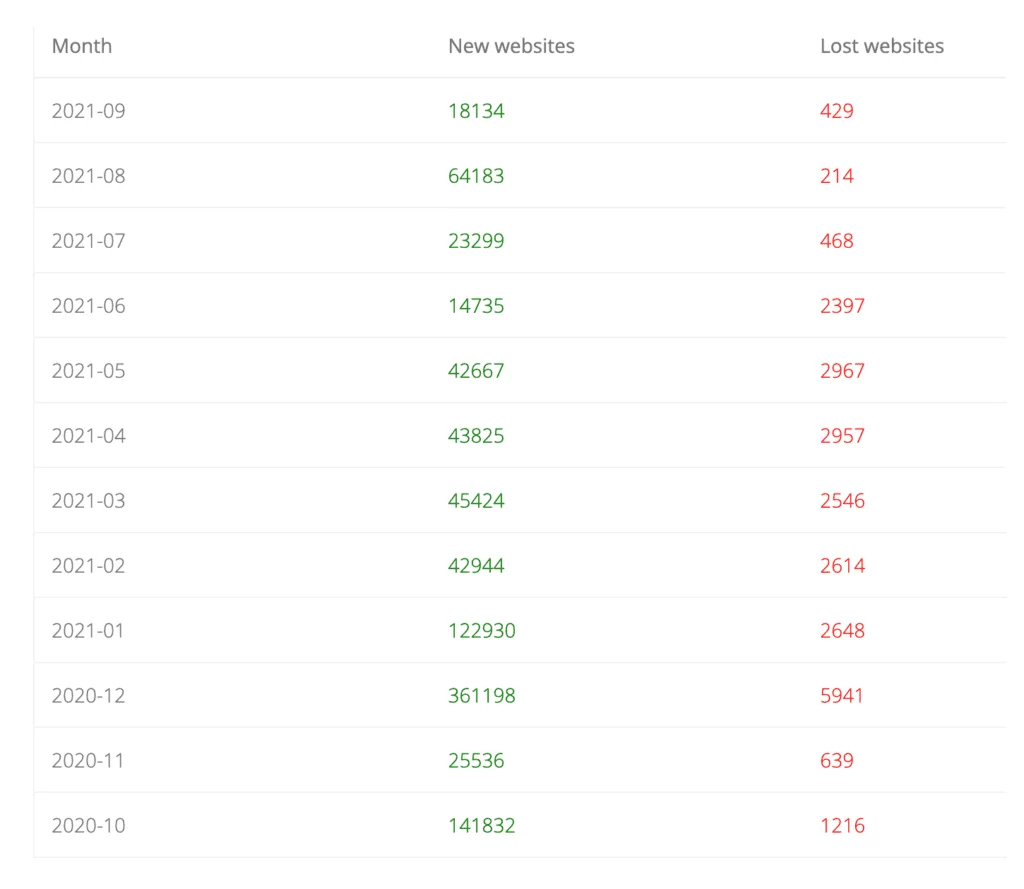
In the list above by ShopRank, you can see WooCommerce’s list of other new websites and the list of lost websites every month from 2020-10 to 2021-09.
By looking at the difference between additional new and lost websites, you can see how trendy this platform is. And the traffic growth is also quite astonishing.
WooCommerce Movement
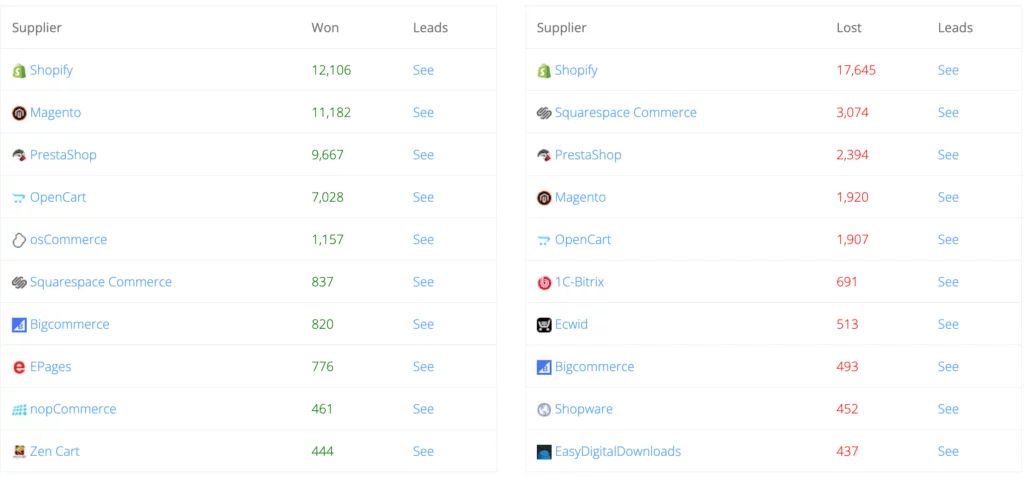
The above list shows the number of websites WooCommerce is gaining and losing at the same time from its competitors. The left side shows the list of the top competitors from which WooCommerce is gaining customers and the number of winning customers.
The right side of the list shows the name of the top competitors from which WooCommerce is losing customers and the number of customers they’re losing.
According to the ranked list of the top 10, WooCommerce is winning more than it’s losing customers from the following competitors,
- Magento
- PrestaShop
- OpenCart
- osCommerce
- Bigcommerce
- ePages
- nopCommerce
- Zen Cart
And this is the list of the competitors that WooCommerce is losing more than its winning customers.
- Shopify
- Square Space
- 1C-Bitrix
- Ecwid
- Shopware
In the top 10, there are eight competitors from which WooCommerce is winning more customers than it is losing. And from five competitors, it’s losing more than it’s winning, which is much lower than the first list. So you see, WooCommerce is doing pretty well in gaining websites from its competitors.
WooCommerce Vs. Shopify: The Ultimate Battle Between Two eCommerce Giants
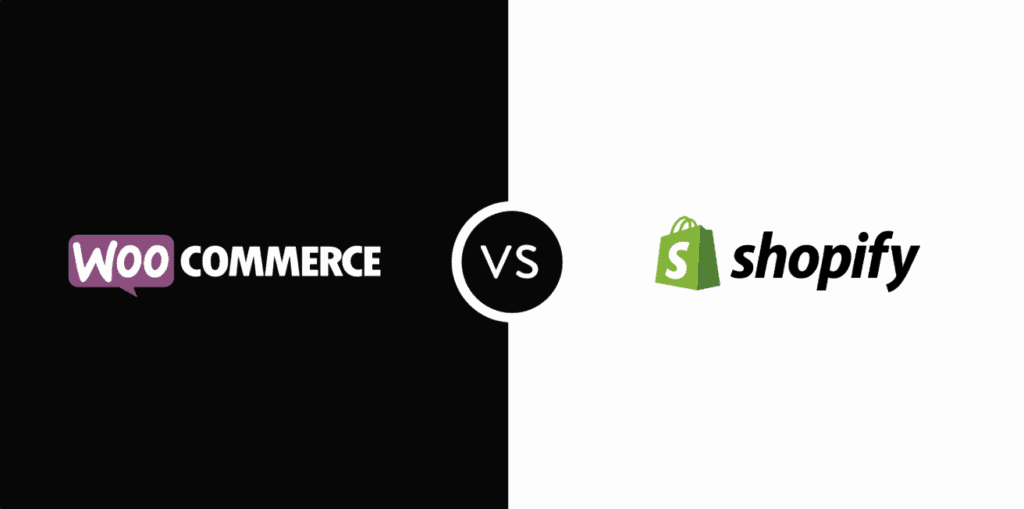
At this point, we will simply start comparing WooCommerce with Shopify in some primary comparison criteria and come up to a conclusion. WooCommerce and Shopify are considered inarguably two of the leading and most competitive platforms in the eCommerce industry.
Here, we will compare these two giant competitors based on five criteria. These are cost comparison, user-friendliness/user convenience, payment gateway integration & Add-ons, and scalability. So without further ado, let’s begin our comparison.
Cost is one of the most important considerations for any eCommerce business owner. Let’s discuss the actual cost of using WooCommerce and Shopify one by one, compare their costs, and find out a winner for this segment. Shall we?
1. Cost Comparison: WooCommerce Vs. Shopify
Real Costing of WooCommerce
WooCommerce is an open-source and free-of-cost eCommerce plugin for WordPress.org. Although you’ll need a domain name, SSL Certificate, and a WordPress hosting account to get into the eCommerce business via WooCommerce.
Usually, a domain name costs about $15, SSL Certificate costs $70, and web hosting costs around $8 per month. Looking at those numbers, you can say that it’s anything but cheap. But fortunately for us, there are multiple hosting companies offering specialized hosting plans for WooCommerce, which reduces the cost significantly.
Bluehost is one of the most popular and official WordPress & WooCommerce recommended hosting providers. They have agreed to provide the WooCommerce users with a free domain name, SSL certificate, and discounted web hosting. By this, you can start your online store with only $2.75 per month.

Another good thing about WooCommerce is that they don’t charge you any percentage fee on the transaction, which is a nice touch. But always keep in mind that WooCommerce costs will increase as you start purchasing paid extensions. And the hosting cost will also go up as your online store starts growing.
However, the good thing is that you don’t need to worry about the costing too much as you can easily handle the cost as your store will also grow along with it.
Another clear advantage WooCommerce has is that you’ll often find free alternatives to premium themes and paid extensions. It’ll keep your cost low as you only need to purchase the necessary tools and plugins only when you need them.
Real Costing of Shopify
Shopify has the easiest option to start up your online store. They have in total three plans for their customers, starting with $29 per month. Their upgraded plan costs $79 per month, and the advanced plan costs $299 per month.

All these plans come with an SSL certificate, web hosting, and a Shopify branded subdomain. To use your own .com domain name, you need to purchase it separately, which usually starts at $14 per year.
However, the initial pricing does not include any third-party tools or add-ons that you’re going to need to take your Shopify store to another level. The cost will soon start to go up along with your business growth.
Shopify also has another costing for the payment solution. Unlike WooCommerce, Shopify doesn’t have a free-of-charge transaction process. If you use their own Shopify Payment Solution, it’ll cost you 2.9% + 30 cents per transaction for the basic plan.
And any third-party payment gateways or your merchant account will cost you a flat fee of 2.0% for all transactions. This fee can be reduced to 0.5% percent if you get your subscription to the Shopify Advanced plan that costs $299 per month.
Result: After what we have discussed, it’s pretty much clear that there’s no comparison between WooCommerce and Shopify regarding the costing. With the number of free themes and add-ons available for WooCommerce, it’s the clear winner of this segment.
Winner: WooCommerce.
2. User-friendliness
Most people who want to get into the eCommerce business are not web designers or developers. So it’s essential to make the platform as user-friendly as it gets. Let’s see how these two companies compete in terms of user experience.
WooCommerce User-friendliness
WooCommerce is not a hosted platform. So, you need to install the WooCommerce plugin, manage updates, keep backups, and secure your website.
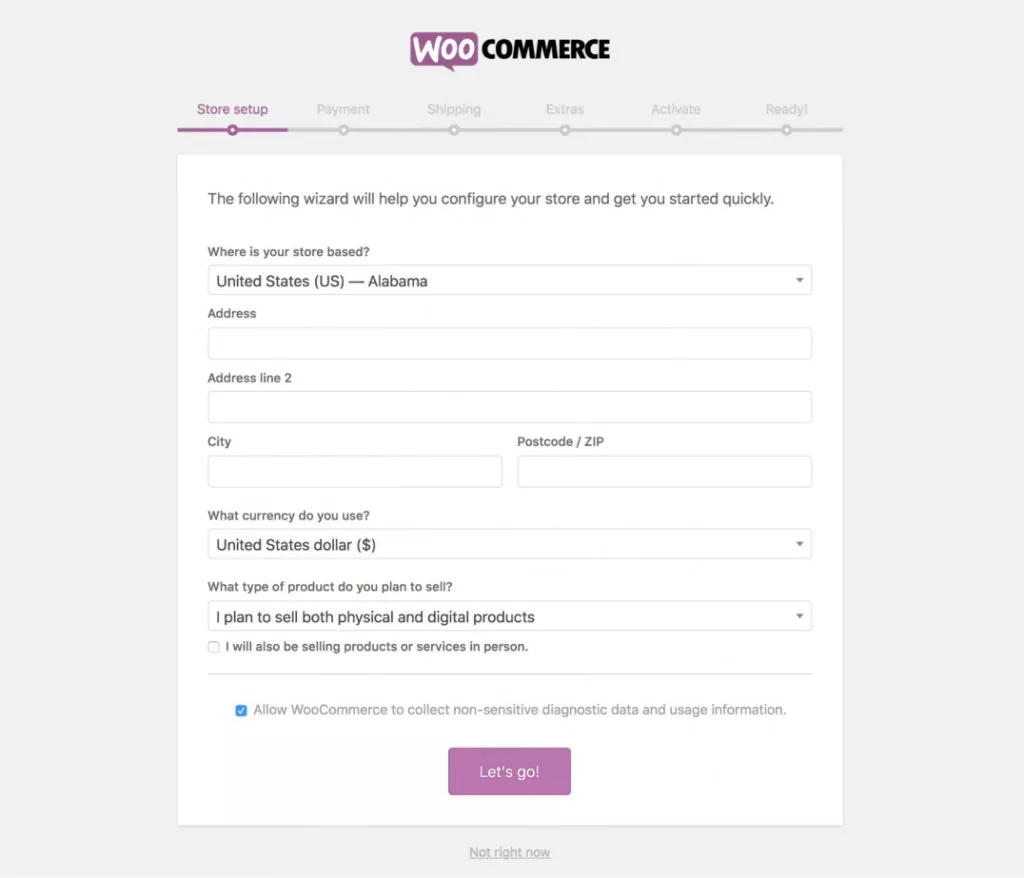
But the best thing about WooCommerce is it’s an open-source plugin. That means it’s super flexible when it comes to customizations. You have complete control over your website and can add any functionality you can imagine to your website.
However, one of the most significant downsides of flexibility is that it comes with a learning curve, which requires more hands-on management of your website. You’ll also need to sign up for a merchant account or similar service like PayPal, Stripe, etc.
Shopify User-friendliness
Shopify is a fully hosted platform. So unlike WooCommerce, you don’t need to install, manage, or update any software. Also, you don’t need to worry about the security of your website, backups, performance, and compatibility issues either.
As you sign up, you can choose a design from many free Shopify themes. After that, they’ll give you a walkthrough for customization and help you to add up your products.

Shopify comes with a built-in drag and drop interface, which WooComerce doesn’t have. It allows you to manage your product pages, sales, and inventory inside Shopify.
One major downside of this guided, polished, and highly optimized user experience is limiting your control over your online store. You can only use their provided design, tools, and add-ons available in the Shopify marketplace.
However, for most users, the vast selection of theme designs and extensions available in their marketplace is more than enough for starting up your online store and growing.
Result: After the complete comparison between WooCommerce and Shopify regarding user experience, we finally came up with the result. Though we believe that WooCommerce Guided Setup Wizard is helpful, it doesn’t come close to Shopify’s onboarding experience and ease of use. So, in this segment, the winning trophy goes to Shopify.
Winner: Shopify
3. Payment Method
There are so many payment gateways you can use to accept payments online. Among all the options, some methods might not suit you, and others might not be available to your customers. Let’s see how these two rivals compete with each other in this segment.
Payment Options in WooCommerce
By default, WooCommerce offers PayPal and Stripe payments. It also has a WooCommerce Payments Solution powered by Stripe.
WooCommerce supports all other popular payment options like Authorize.net, Amazon Pay, Square, Alipay, and many more. It also supports less popular and regional payment services since it’s an open-source plugin, and there’s no barrier to entry.

Being a self-hosted platform, you’ll only be charged transaction fees by your payment gateway or bank. Unless you are using WooCommerce payments, they will never charge a penny on credit card payments, which is a significant plus point.
If you can manage to choose your merchant account and use a third-party gateway, then you can have a lot of money using WooCommerce.
Payment Option in Shopify
Shopify also has many payment options available for their customers, including their own payment solution, Shopify Payments, powered by Stripe. They also accept all the third-party payment gateways.

But the real problem is Shopify charges an extra 2% fee on each transaction through any third-party payment gateways. To reduce the fee to 0.5%, you need to pay $299 per month for the Advanced Shopify Plan.
If you choose Shopify payments as your payment gateway, it will cost you 2.9% + 30 cents for the basic plan. The cost will go down as you upgrade your initial plan.
Result: WooCommerce supports almost every payment gateway option and charges less than Shopify’s transaction process. So, WooCommerce seals the victory in this segment.
Winner: WooCommerce.
4. Integration and Add-ons
It doesn’t matter how robust an eCommerce site is. You’ll always need some third-party tools and services to grow your store. In terms of Integration and Add-ons, both WooCommerce and Shopify have their own extensions directory to integrate with many third-party services.
WooCommerce Integration and Add-ons

WooCommerce is an open-source plugin built on top of WordPress. It has access to more than 58000+ free WordPress plugins and many more paid ones.
By using these Add-ons, you can add payment gateways, lead generation, eCommerce SEO, performance optimization, social media integration, and many more.
Because of the lower barrier of entry, WooCommerce has a lot more integration and add-ons available than Shopify. Almost every third-party tool and plugin can be seamlessly integrated with your WooCommerce store.
Shopify Integration and Add-ons
Shopify has a powerful API and an App Store where you can buy any third-party add-ons for your Shopify store. They have hundreds of apps in the store that should cover every feature you add to your store.
Shopify has integration with software like OptinMonster that helps you grow your email list and reduce cart abandonment. They also have apps for SEO, product reviews, discounts, countdowns, and many more.
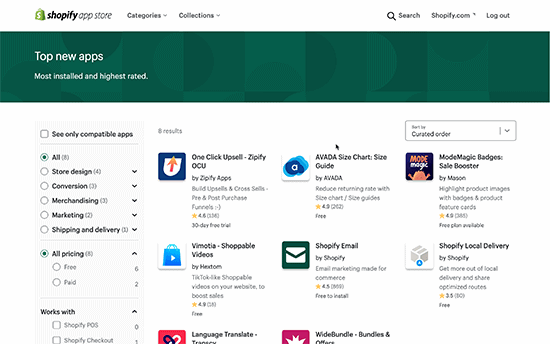
Like WooCommerce extensions, plugins, and themes, Shopify’s App Store also contains free and paid apps. But in terms of numbers, there are fewer add-ons and extensions in Shopify compared to WooCommerce. That’s because, unlike WooCommerce, it’s not easy for a third-party company to get their app listed in Shopify’s app store.
Result: Considering the complicated process of submitting an app to the Shopify store and the vast availability of add-ons in the WooCommerce platform, we can say that WooCommerce performs better than Shopify for integration and customization.
Winner: WooCommerce.
5. Scalability and Growth
When your business starts growing, you’ll need more resources to face new challenges and pursue new goals. Now let’s see how these two titans perform face to face when it comes to scalability and growth.
WooCommerce Scalability and Growth
As a self-hosted platform, maintaining updates, backups, and security of your website might get a little tricky for the users. Also, your initial hosting plan would run out of resources as you start getting more traffic in your store.

However, the good news is that you’ll get plenty of options to manage your business growth as you have complete control over your store. Your hosting cost might increase, but you’ll have better control over the specific resources you upgrade.
You can also use SiteGround or WP Engine to scale your WooCommerce store.
Shopify Scalability and Growth

Shopify handles the technical aspects of your store so that you don’t have to worry about your store’s security, performance, and scalability. You can simply upgrade your Shopify plan along with your business growth.

You don’t have to worry about downtimes, backups, updates, or security either, as their infrastructure handles every one of them.
The process of your business growth via Shopify is indeed a little costly. But the bright side is it can get omitted because you don’t have to hire or manage an in-house technical team.
Result: Despite the total control that WooCommerce offers, most businesses prefer hassle-free and straightforward solutions. So, considering that Shopify gets this round in my book.
Winner: Shopify.
Battle Result Evaluation
Segments won by WooCommerce
- Cost
- Payment Method
- Integration and Add-ons
Segments won by Shopify
- User-friendliness/User experience
- Scalability and Growth
Final Result
After the head-to-head comparison and the ultimate battle between these two eCommerce giants, we came up with the final result – WooCommerce beats Shopify in this hard-fought battle by 3-2.
ShopRank Stats on WooCommerce Vs. Shopify
Now, let’s have a look at some of the statistics on WooCommerce Vs. Shopify from the ShopRank website.
WooCommerce Vs. Shopify Trends

From the statistics above, you can see that WooCommerce is well in front of Shopify when it comes to the numbers. In the last four months, the number of newly added websites on WooCommerce has been far ahead of the numbers of Shopify.
Though the number of lost websites of WooCommerce is also higher than Shopify, the margins are considerably low. So the stats also support my previous head-to-head battle result; WooCommerce is still very much advanced than Shopify.
WooCommerce Vs. Shopify Website Distribution in Top 3 Million Websites (Ranked by Alexa)

The above statistics by Alexa Rank show WooCommerce and Shopify’s website count in the top 3 Million websites worldwide. Here if you only take websites ranked between 1 to 100k, then Shopify is ahead of WooCommerce. But after 100k to 3M, the numbers of WooCommerce are way higher than Shopify.
That shows that when you only consider the top-ranked websites, then Shopify is dominating there. But if you talk about total domination in terms of website count, then WooCommerce is pretty much dominating its primary competition, Shopify.

WooCommerce Vs. Magento: How Different Are These Two Companies?
Magento is also a top-rated eCommerce platform alongside other popular platforms like WooCommerce and Shopify. In this part of my writing, we will not directly send WooCommerce and Magento to a head-to-head battle. Here, we’ll emphasize more on the similarities and the differences between WooCommerce and Magento. Especially in the context of performance, scalability, and solutions like Magento 2 enterprise hosting.

If you talk about similarities, WooCommerce and Magento are very similar in being open-source and PHP programming language-based platforms. They both require hosting packages like Nexcess or WP Engine to run the software.
Despite the similarities, Magento and WooCommerce have plenty of differences as well. Magento is a far more complicated and robust eCommerce platform than WooCommerce. And if you have a closer look, you’ll see these two companies have their different set of target users.
Both the companies have their very own strengths and weaknesses. In this part of the blog, we will talk about all the things we’ve mentioned above and come up with a final verdict.
Feature Comparison
| Serial No. | WooCommerce | Magento |
| 1. | WooCommerce is an entirely free platform. | Magento has a free Community Version. And it offers other paid premium services as well. |
| 2. | A self-hosted platform. That means you have to find your own web hosting to run your website. | The free Community Version is self-hosted. But their paid premium services include hosting. |
| 3. | It supports almost every theme available at WordPress.org. WooCommerce also offers its users an enormous option for customization. | Not as much as WooCommerce, but Magento also offers a theme-based system and plenty of customization options. |
| 4. | WooCommerce offers an extension system that comes with hundreds of options. | Not as much as WooCommerce, but Magento also supports extensions that offer a wide variety of options. |
| 5. | Supports unlimited products. | Enables you to add unlimited products. |
| 6. | It has pretty basic security features to protect your store. | It offers you an advanced security feature alongside dedicated patches to disclose any arising vulnerabilities. |
| 7. | A very pleasing user experience. WooCommerce platform is remarkably easy to use, even for the non-tech person. | Magento is recommended for users that have at least a basic level of web development/technical knowledge. |
Pros and Cons of WooCommerce

Pros
- WooCommerce is a plugin within WordPress. So, you get the value of WordPress CMS.
- Besides web hosting expenses, store setup is free of cost.
- Typically lower cost of ownership.
- Easy to use. No technical or web development knowledge is needed.
- Lower learning curve.
- Works excellent with content-focused websites that can take advantage of the WordPress CMS.
- It’s great for sites selling downloadable content like eBooks, podcasts, etc.
- Tons of documentation is available for user convenience.
- It is capable of integrating with Google Analytics via an extension.
- Many plugins are available that are absolutely free of cost.
- WooCommerce includes SSL support until you have your own SSL certificate.
- It has the largest open source community and user base.
Cons
- If you’re not familiar with WordPress, then you need to learn two separate platforms.
- Premium themes and extensions might get a little costly.
- Sometimes it takes many additional WooCommerce plugins to achieve ideal functionality.
- Comparatively weak product data capabilities for large and complex catalogs.
- There’s only one version of WooCommerce available in the market.
- Comparatively lower scalability for large sites.
Pros and Cons of Magento

Pros
- Magento is well known for its scalability. It has enough power to handle larger stores as long as the host can manage them.
- Magento is mainly enterprise-focused. Apart from that, it has other versions like open-source, cloud, etc.
- Has a large amount of out-of-the-box functionality.
- A massive community of extraordinary developers and support from big agencies.
- Faster checkout process. Also, guest checkout is turned on by default.
- Strong B2B eCommerce capabilities.
- Capable of handling strong product data for large and complex catalogs.
- Robust order management and promotional capabilities.
- By default, it integrates with PayPal, Authorize.Net, and Braintree.
Cons
- Magento feels like it’s targeted a little more towards developers than regular users.
- Higher learning curve.
- Comparatively higher cost of ownership and hosting.
- Weak CMS capabilities for sites with heavy content.
- Extra maintenance cost for larger applications.
- More extensions cost more money.
- Complicated front-end theming.
Quick Summary
To summarize all the comparisons and discussions above, let’s look at the following quick comparison chart below.
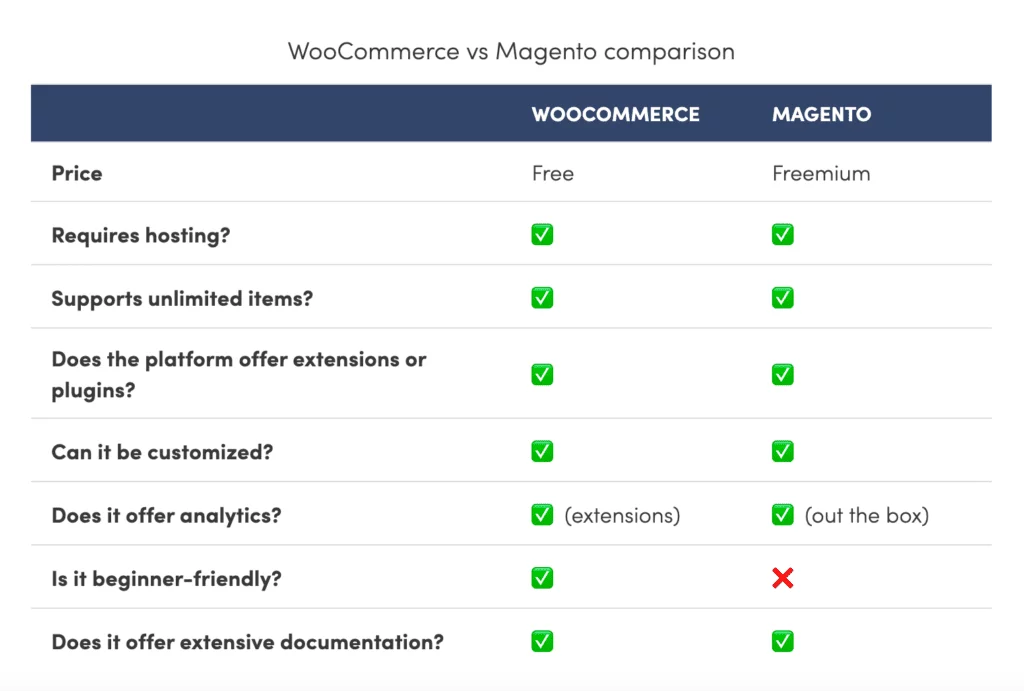
ShopRank Stats on WooCommerce Vs. Magento
Now, let’s have a look at some of the statistics on WooCommerce Vs. Magento from ShopRank website.
WooCommerce Vs. Magento Trends

From the statistics above, you can see that WooCommerce is far ahead of Magento when it comes to raw numbers. In fact, the difference of numbers between WooCommerce and Magento is so big that you can almost say there is no comparison between these two companies.
Though the number of lost websites of WooCommerce is slightly higher than Magento, the margins are considerably shallow. So, according to the above stats from ShopRank, it’s pretty much clear that WooCommerce is well in front of Magento in terms of market trends.
WooCommerce Vs. Magento Website Distribution in Top 3 Million Websites (Ranked by Alexa)

The above statistics by Alexa Rank show WooCommerce and Magento’s websites count in the top 3 Million websites worldwide. If you only take the first section of the list, which is ranked between 1 to 10k, Magento is ahead of WooCommerce.
But after 10k up to 3M, the numbers of WooCommerce are much much higher than Magento. In fact, Magento is no way near the numbers of WooCommerce.
That shows that if you only consider the top-ranked websites, then Magento is slightly ahead of WooCommerce. But if you talk about total domination in terms of website count, then WooCommerce is definitely in the driving position.
If you enjoy reading WooCommerce vs Shopify and WooCommerce vs Magento, we would like to recommend you our another comparative Blog between WooCommerce vs BigCommerce. We’re pretty sure you’ll enjoy that one as well!

Final Verdict
Many congratulations to you if you managed to come up to this point of this blog. Now you know everything necessary about WooCommerce market share and how it’s performing against its core competitors Shopify and Magento, in detail. Let’s wrap it up. Shall we?
We have already done our part by spreading whatever information we’ve managed to gather with you all. Now it’s time to do yours. Comment below which platform you find best suited for your eCommerce business. And why?
Is it WooCommerce, Shopify, or Magento? Or is it some other platform from the bucket? Hurry up, and do let me know. We will very much appreciate it. We hope you find the blog helpful. Still, if you find anything hard to understand or have any queries, feel free to get back to us anytime.

Great writing! Thank you sharing so much valuable data through your post.
Hi! Thanks for taking the time to read the article and glad to know it helped you.